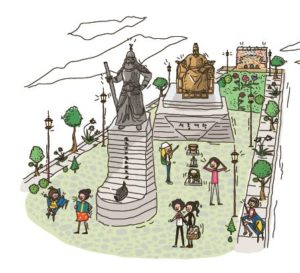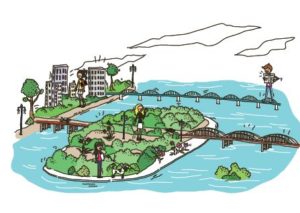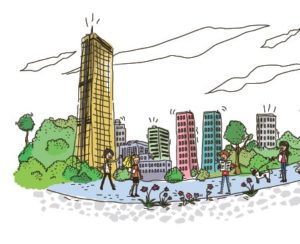
To be greener and more eco-friendly
- Date 2014-08-01 09:05
- CategoryNews
- Hit1703
 Located in the Northwest of Korea, Seoul is the largest metropolis and the capital of the Republic of Korea. With its twenty-five districts, Seoul covered the land area of 605km2 which is equal to around 0.6% of the country’s total land, and is populated by 10,528,000 people, according to data shown in the official website of the Seoul Metropolitan Government. As the world’s 15th largest economy, there is no doubt that this rising global city is filled up with various high-rise buildings and luxurious offices, advanced IT technologies and mass transportation system. As with any advanced industrial city with rapid development, however, Seoul faces some environmental challenges resulting from traffic congestion, greenhouse gas emissions and energy consumption. Responding to those problems, the metropolitan government, in line with the National Strategy for Green Growth (2009-2050), is trying to make Seoul to be greener and more eco-friendly by implementing a key environmental policy: increasing green spaces and parks.
Located in the Northwest of Korea, Seoul is the largest metropolis and the capital of the Republic of Korea. With its twenty-five districts, Seoul covered the land area of 605km2 which is equal to around 0.6% of the country’s total land, and is populated by 10,528,000 people, according to data shown in the official website of the Seoul Metropolitan Government. As the world’s 15th largest economy, there is no doubt that this rising global city is filled up with various high-rise buildings and luxurious offices, advanced IT technologies and mass transportation system. As with any advanced industrial city with rapid development, however, Seoul faces some environmental challenges resulting from traffic congestion, greenhouse gas emissions and energy consumption. Responding to those problems, the metropolitan government, in line with the National Strategy for Green Growth (2009-2050), is trying to make Seoul to be greener and more eco-friendly by implementing a key environmental policy: increasing green spaces and parks.

Everywhere in Seoul, you’ll see trees and flowers. Where sidewalks exist, trees make a natural barrier between cars and pedestrians. The green views also go up to the rooftop of many buildings in Seoul, thanks to the efforts of the government that has encouraged building owners to form green spaces on their rooftops.
In the same vein, many parks have been built in Seoul. Up to now, there are 16 major public parks in total, including World Cup Park, Olympic Park, Seoul Forest and Dream Forest parks. Those parks have been designed with the environment-friendly setting where Seoul citizens can enjoy their green views and relax after a tiring day. Especially on weekends, all the park grounds turn very crowded. A lot of people come to the park to bike, to jog or just to take a walk.
 The metropolitan government has been committed to creating a sustainable urban environment in Seoul through large-scale projects such as the restoration of Cheonggyecheon Stream and the Han River renaissance. Cheonggyecheon is a 5.8km-long restored stream, located in the downtown Seoul. At both sides of the stream there are various kinds of plants which draw two green lines in the heart of Seoul. Meanwhile, the Han River renaissance project has vastly improved accessibility to the waterway. The transformation has attracted more and more activities on the river banks. Nowadays the Han River, which the metropolitan government calls ‘a new hope for Seoul’, is emerging as one of the most representative recreation parks for millions of Seoul citizens.
The metropolitan government has been committed to creating a sustainable urban environment in Seoul through large-scale projects such as the restoration of Cheonggyecheon Stream and the Han River renaissance. Cheonggyecheon is a 5.8km-long restored stream, located in the downtown Seoul. At both sides of the stream there are various kinds of plants which draw two green lines in the heart of Seoul. Meanwhile, the Han River renaissance project has vastly improved accessibility to the waterway. The transformation has attracted more and more activities on the river banks. Nowadays the Han River, which the metropolitan government calls ‘a new hope for Seoul’, is emerging as one of the most representative recreation parks for millions of Seoul citizens.
With various city government initiatives to increase green spaces and parks across the city, Seoul is becoming cooler and greener beckoning its citizens to nature.
By Sopheana Brohn (2013 MPP, Cambodia)
Related News
-
News631 days ago
『2021 KSP Annual Report』 released -
News1024 days ago
Never Refuse to Reuse#Eco-Friendly #KDIS #Environment #kdischool #precycling #PURE campaign #recycling #upcycling
-
News1088 days ago
Precycling, A Great Way to Conserve the Environment#Eco-Friendly #KDIS #Environment #kdischool #live green #green #go green
